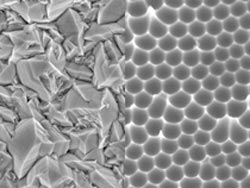The tarte tatin throws a new light on photovoltaics

Layers of zinc oxide seen through an electron microscope. On the left: natural pyramid structure; on the right: structure when grown on a mould (height of images: 5 microns).<br>© PV-LAB, EPFL/SNSF<br>
Their specialty: manufacturing solar cells that are one thousand times thinner than conventional cells. In order to boost the output of the cells, they have developed a new nanopatterning technique.
Even though silicon is one of the most abundant elements, the energy required to make silicon from sand is immense. It is for this reason, but also to reduce manufacturing costs, that Professor Christophe Ballif and his team from the Photovoltaics and Thin-Film Electronics Laboratory at the EPFL have been working for several years on thin-film silicon solar cells that are a thousand times thinner than conventional cells.
Better light absorption
There’s just one catch: the thinner the cells, the less they absorb the rays of the sun and the less electricity they produce. So researchers are trying to trap light in the thin silicon layers to increase their absorption. Traditionally, thin layers of zinc oxide—a material that is very abundant, completely non-toxic, and that grows in the form of small pyramid-shaped crystals—are used for this purpose. These crystals scatter light efficiently into the underlying silicon layer. With such zinc oxide layers, even a new world record cell efficiency was achieved.
Reducing costs
But scientists are attempting to beat this record. “It is difficult to modify the natural pyramidal shape of these crystals in order to obtain even better light scattering,” explains researcher Corsin Battaglia, “so we had the idea to force the crystals to grow on a different support, an inverted mould with the desired structure.” The idea is as ingenious as it is simple. Once the thin layer of zinc oxide is deposited on the mould all that needs to be done is to “demould” it—as you would a tarte tatin, for example—to obtain a film with the desired structure. This procedure, described in the September edition of the journal Nature Photonics (*), not only increases the amount of light that is trapped, thereby increasing output, but it also has the potential to reduce the cost of the cells because of its compatibility with mass production. These are interesting arguments at a time when photovoltaics is seeking to produce electricity at a lower price than the current grid price.
(*) Corsin Battaglia, Jordi Escarré, Karin Söderström, Mathieu Charrière, Matthieu Despeisse, Franz-Josef Haug and Christophe Ballif (2011). Nanomoulding of transparent zinc oxide electrodes for efficient light trapping in solar cells. Nature Photonics online. doi: 10.1038/NPHOTON.2011.198
(available in PDF format from the SNSF; e-mail: com@snf.ch)
Contact :
Dr. Corsin Battaglia
Swiss Federal Institute of Technology, Lausanne
Photovoltaics and Thin-Film Electronics Laboratory
Institute of Microtechnology
Rue A.-L. Breguet 2
CH-2000 Neuchâtel
Tel.: +41 (0)32 718 33 34
E-mail: corsin.battaglia@epfl.ch
Media Contact
All latest news from the category: Process Engineering
This special field revolves around processes for modifying material properties (milling, cooling), composition (filtration, distillation) and type (oxidation, hydration).
Valuable information is available on a broad range of technologies including material separation, laser processes, measuring techniques and robot engineering in addition to testing methods and coating and materials analysis processes.
Newest articles

Magnetic Memory Unlocked with Energy-Efficient MRAM
Researchers from Osaka University introduced an innovative technology to lower power consumption for modern memory devices. Stepping up the Memory Game: Overcoming the Limitations of Traditional RAM Osaka, Japan –…

Next-Level System Security: Smarter Access Control for Organizations
Cutting-Edge Framework for Enhancing System Security Researchers at the University of Electro-Communications have developed a groundbreaking framework for improving system security by analyzing business process logs. This framework focuses on…

How Microbial Life Shapes Lime Formation in the Deep Ocean
Microorganisms are everywhere and have been influencing the Earth’s environment for over 3.5 billion years. Researchers from Germany, Austria and Taiwan have now deciphered the role they play in the…



